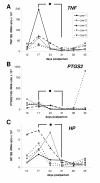Time-dependent mRNA expression of selected pro-inflammatory factors in the endometrium of primiparous cows postpartum
- PMID: 21176181
- PMCID: PMC3016299
- DOI: 10.1186/1477-7827-8-152
Time-dependent mRNA expression of selected pro-inflammatory factors in the endometrium of primiparous cows postpartum
Abstract
Background: Inflammatory processes and infections of the uterine wall must be accepted as a physiological event in dairy cows after calving. This might result in clinical or subclinical endometritis which is assumed to impair reproductive performance in the current lactation. Several cytokines and acute phase proteins have been discussed as local and systemic mediators of these inflammatory processes. The aim of the present study was to investigate the endometrial mRNA expression of the chemokine CXC ligand 5 (CXCL5), interleukin 1β (IL1B), IL6, IL8, tumour necrosis factor alpha (TNF), prostaglandin-endoperoxide synthase 2 (PTGS2) and haptoglobin (HP) in the postpartum period.
Methods: Endometrial samples were obtained from primiparous cows (n = 5) on days 10, 17, 24, 31, 38 and 45 postpartum (pp) using the cytobrush technique. Cytological smears were prepared from cytobrush samples to determine the proportion of polymorphonuclear neutrophils (PMN). Total RNA was extracted from endometrial samples, and real-time RT-PCR was performed.
Results: A time-dependent mRNA expression of the investigated factors was found for the course of the postpartum period. In detail, a significantly higher expression of these factors was observed on day 17 pp compared to day 31 pp. Furthermore, the proportion of PMN peaked between days 10-24 pp and decreased thereafter to low percentages (< 5%) on day 31 pp and thereafter. In addition, CXCL5, IL1B, IL8 and HP mRNA expression correlated significantly with the proportion of PMN (P < 0.05). A significantly higher CXCL5, IL1B, IL6, IL8, PTGS2 and TNF mRNA content was observed in samples from cows with an inflamed endometrium compared with samples from cows with a healthy endometrium (P < 0.05).
Conclusions: These results show that inflammatory cytokines and acute phase proteins are expressed in the bovine endometrium in a time-related manner during the postpartum period, with a significant expression peak on day 17 pp as a possible mucosal immune response in the uterus. The evaluation of the expression patterns of such candidate genes may reveal more information than only determining the percentage of PMN to judge the severity of an inflammation.
Figures



Similar articles
-
Selected pro-inflammatory factor transcripts in bovine endometrial epithelial cells are regulated during the oestrous cycle and elevated in case of subclinical or clinical endometritis.Reprod Fertil Dev. 2010;22(5):818-29. doi: 10.1071/RD09120. Reprod Fertil Dev. 2010. PMID: 20450834
-
Endometrial mRNA expression of selected pro-inflammatory factors and mucins in repeat breeder cows with and without subclinical endometritis.Theriogenology. 2017 Mar 1;90:237-244. doi: 10.1016/j.theriogenology.2016.12.013. Epub 2016 Dec 14. Theriogenology. 2017. PMID: 28166974
-
Endometrial expression of selected transcripts in postpartum of primiparous Holstein cows with clinical and subclinical endometritis.Anim Reprod Sci. 2015 May;156:34-9. doi: 10.1016/j.anireprosci.2015.02.007. Epub 2015 Feb 21. Anim Reprod Sci. 2015. PMID: 25746855
-
Progesterone-independent endometrial mRNA expression in dairy cows with clinical or subclinical endometritis.Theriogenology. 2024 Mar 1;216:146-154. doi: 10.1016/j.theriogenology.2023.12.031. Epub 2023 Dec 30. Theriogenology. 2024. PMID: 38183931
-
A review of the ongoing discussion about definition, diagnosis and pathomechanism of subclinical endometritis in dairy cows.Theriogenology. 2017 May;94:21-30. doi: 10.1016/j.theriogenology.2017.02.005. Epub 2017 Feb 12. Theriogenology. 2017. PMID: 28407857 Review.
Cited by
-
Pathogenesis of uterine diseases in dairy cattle and implications for fertility.Anim Reprod. 2018 Aug 3;15(Suppl 1):879-885. doi: 10.21451/1984-3143-AR2018-0023. eCollection 2018 Jul-Sep. Anim Reprod. 2018. PMID: 36249851 Free PMC article.
-
Cervico-vaginal mucus (CVM) - an accessible source of immunologically informative biomolecules.Vet Res Commun. 2018 Dec;42(4):255-263. doi: 10.1007/s11259-018-9734-0. Epub 2018 Aug 16. Vet Res Commun. 2018. PMID: 30117040 Free PMC article.
-
Uterine infection alters the transcriptome of the bovine reproductive tract three months later.Reproduction. 2020 Jul;160(1):93-107. doi: 10.1530/REP-19-0564. Reproduction. 2020. PMID: 32422601 Free PMC article.
-
Associations among serum pro- and anti-inflammatory cytokines, metabolic mediators, body condition, and uterine disease in postpartum dairy cows.Reprod Biol Endocrinol. 2013 Nov 9;11:103. doi: 10.1186/1477-7827-11-103. Reprod Biol Endocrinol. 2013. PMID: 24209779 Free PMC article.
-
An in vitro comparison of antimicrobial efficacy and cytotoxicity between povidone-iodine and chlorhexidine for treating clinical endometritis in dairy cows.PLoS One. 2022 Jul 8;17(7):e0271274. doi: 10.1371/journal.pone.0271274. eCollection 2022. PLoS One. 2022. PMID: 35802692 Free PMC article.
References
Publication types
MeSH terms
Substances
LinkOut - more resources
Full Text Sources
Research Materials
Miscellaneous

